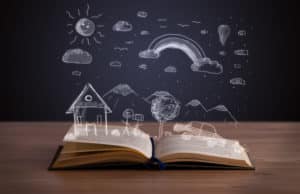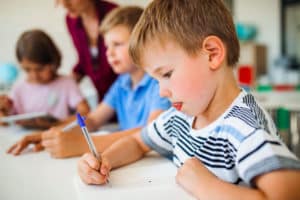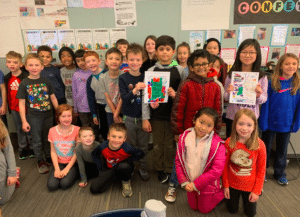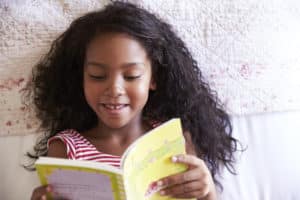 As teachers, we all know the importance of reading comprehension in elementary school. Our students’ ability to process the written word, understand its meaning and integrate that into what they already know is a cornerstone of their education—and their whole lives.
As teachers, we all know the importance of reading comprehension in elementary school. Our students’ ability to process the written word, understand its meaning and integrate that into what they already know is a cornerstone of their education—and their whole lives.
In addition, being able to follow the organization and sequencing of a story, as well as identify its point of view and draw inferences from its content, is crucial for the entirety of their educational careers. And of course, reading books is where they get that practice.
Book reports are a classic part of the elementary school experience. They help students learn to summarize what they’ve read, gain a deeper understanding of the content and develop their writing and artistic skills.
By asking your students to think about different elements of a story—looking for constructive details—and by having them share their interpretation of a book, they learn to read more deeply, explore beyond their own lives and appreciate literature for all the riches it contains. But what fun is it to simply fill out those traditional book report worksheets?
After we dive into the various story elements to go over with your students, you’ll find twenty creative book report ideas for third graders to help them bring the stories they read to life.
Components of a Story

First, students need to know what constitutes a story. It’s important that they learn to identify different elements of a book, which will aid their overall understanding of its content. Then, have them select a book from a pre-approved list for the book report project and ask them to explain why they chose that book.
You’ll want to discuss the following elements that make up a story in a typical book:
- Genre Is it fiction (made up) or nonfiction (real)?
- Setting Where is the story set, and why is it important? How might the setting contribute to its overall meaning?
- Characters Who are the main characters of the book, and what personality traits do they have? Is the main character of the story the same at the end of the book, or do they change? What about the other book characters?
- Point of View Who is telling the story? Is it told from a first-person or a third-person perspective?
- Plot What is happening in the story?
- Conflict/Problem What is the main issue in the book?
- Theme: What is the main theme of the story? Why did the author write the book?
- Symbolism Are there any obvious symbols in the story, and, if so, how do they contribute to its overall meaning?
- Foreshadowing Were there any hints as to what happens later in the story? Were there any big surprises? Why might the author have chosen to provide such clues (or not)?
- Solution Was the main issue of the book resolved? How did the main characters end up dealing with the conflict in the story?
- Ending Was the end of the story believable, and did it fit in with the rest of the book? Based on how the story ended, is this a book your students would recommend to a friend?
Now that you’ve covered the basic elements of a story, it’s time to get to the fun stuff! Choose from any of these creative book report project ideas below to get your third graders engaged and excited to explore the wide world of literature and language arts.
Creative Ideas for Book Reports

1. Create a Classbook
Creating a classbook is a fun, engaging and collaborative project that your students can really take pride in. Use any of the following three ideas to have your students create their own individual pages based on the books they read:

#proudauthors at Towne Meadow!
Do a Mini Report Using one piece of paper, have your students summarize the story, identifying the main characters, setting, problem and solution of the book. They can add drawings to illustrate their favorite scenes or symbols from the story.
Write a Poem Have your students create a poem that highlights the main theme of the book, including details about the main characters, setting, conflict and resolution. Click here for Imaginative Ideas for How to Teach Poetry to Elementary Students.
Create a Portrait of a Character from the Book Have your students draw a portrait of their favorite character from the book, being as detailed as possible. They can write the title of the book at the top and add some of the character’s traits, as well as words to describe the book’s setting at the bottom of the portrait.
Once all of your students have created their mini report, poem or portrait, you can combine these to put into your classbook. Then you’ll have a keepsake book of stories, poetry or art that the whole class can enjoy. This will help them remember and learn from not only their own stories, but the books their fellow students read as well.
Are you Enjoying this Content?
2. Character Day Oral Report
Have your students dress up as their favorite character from the book they read. They can each take turns telling the story from the first-person perspective of the character they have chosen. Letting them read, act out a scene or even field questions as their favorite character, can prove a fun exercise for the whole class.
3. T-Shirt Book Report
Let your students create a fun, wearable book report with the help of a plain white T-shirt and some fabric markers or paint. Have them sketch out their report on regular, letter-sized paper before they move onto the T-shirt material. Drawn elements should include the main characters, the setting of the story, any symbols and a summary of the plot that students can show and share with their classmates.
4. Clothes Hanger Book Report Mobile

Clothes hanger mobiles are a creative, easy and fun book project to make and they don’t require a lot of fancy supplies. All that students need is a hanger, some string or yarn, some paper, a hole punch and markers. On a paper across the body of the hanger, students can identify their book.
Then they can cut small cards out and draw or write different elements of the story (like characters and story details) to hang from the hanger with string. Students can also use a paper plate folded in half as the body of their mobile (on which they’ll identify their book) and then dangle their story elements with yarn from that.
5. Sandwich Book Report
Using construction paper, crayons or markers, students can create multilayer “sandwiches” or “hamburgers” for their book report, with each layer of paper representing a different element of the story, with the title on the top “bun” or “bread,” the setting on a layer of “lettuce,” the characters and main conflict of the book on the “meat” and “cheese,” and so on, ending with a summary of how the book wrapped up on the bottom “bun” or “bread.” Finish up the project, by stapling one side to connect the sandwich!
6. Pizza Box Book Report
Students can use an old pizza box or make one from cardboard for this project. On the lid of the box, they can identify the book, main characters, setting and plot, and then have each slice of the pizza pie tell a part of the story from beginning to end.
7. Mint Tin Book Report
Using cards cut to fit inside a mint tin, have your students create a mint tin book report. They’ll make a “cover” design for the outside of their tin and then illustrate a scene from the book for the “inside cover.” The other elements of the story can be written out on cards that fit inside the tin and be layered in order.
8. Cereal Box Book Report
For this project, students can use paper to cover over an old cereal box to make a story “cereal” of their own design. The front of the box will show the “cereal name” (related to the book), along with illustrations of themes, characters or symbols, while the story can be summarized, described and rated on the side panels. Use the back of the cereal box to create a game or activity related to the book.
9. Book Reports in a Bag
First, have your students write a summary of the book they read. Next, they can decorate a paper bag from the grocery store with scenes from the story. Then, have them place five items representing something from the book inside the bag. Finally, each student presents their bag to the class, explaining their illustrations and how each of the items relates to the book they read.
10. Create a Timeline
Students can use several pieces of paper taped together end to end to create a timeline for their book. Then they can use writing and drawing to highlight characters, topics and other story details along the timeline, creating a visual sequence of events to summarize what happened in the book.
11. Book Report Bookmarks
Using construction paper or cardstock along with a hole punch, yarn or string and markers, have your students create several bookmarks that represent their favorite characters or scenes from the book.
12. Create a Blockbuster Poster
This imaginative project allows your students to pretend their book is going to be made into a blockbuster movie. First, have your students sketch their poster ideas on regular, letter-sized paper. They’ll want to think of exciting words related to the story that they can use to draw their “movie audience” in. Next, have them recreate their sketches on a large piece of poster or chart paper. Main characters, setting details and plot should all be represented on the poster.
This project can also easily be turned into a published classbook. All you need to do is order your FREE Classbook Publishing Kit, have your students create their posters using markers and then write a couple of paragraphs summarizing what they read!
13. Design a Book Jacket
Start this creative project by showing your students examples of stellar book jackets, pointing out the front cover with its title and illustration, the spine and that information and the back cover with the summary of the book. You may even want to have them fold the ends of the paper in for flaps on which they can provide more information about the book or the story. Then have them design an all-new jacket for the book they read.
14. Watercolor Rainbow Book Report
First, have your students draw a small portrait or photograph-like picture of the main character of their book. This should be cut out and pasted into the center of a larger piece of poster or chart paper. Next, they’ll draw lines from the image in the center of the paper to the outer edges of the paper, creating “sunshine rays” that are wider on the outer edges.
Using watercolor paints, have your students paint each “sunray” section a different color of the rainbow. Once that is dry, they can fill in each section with information about different elements of the story they read, such as main characters, setting, theme and so on.
16. Peekaboo Book Report
Using the inside of small science report boards or cardboard lap books, have your students list details about their book and its elements on each section. Next, have them draw the head and arms of the main character of their story on sturdy card stock to cut out and attach to the top of the board, making it look like that character is holding and peeking over the top of the report.
17. Book Report Alphabet Book
Of course your third graders are well beyond reading alphabet books, but there’s no reason they can’t design and illustrate them! Have your students create an alphabet book, where each page features a letter of the alphabet, along with a word related to their story that begins with that letter and an eye-catching illustration.
You can choose the best illustration for each letter and publish them together into an awesome classbook that they can look back on for years to come! Take a look at our ABC Classbooks that have been published for some inspiration!
18. Character Diary
This character diary project allows your students to really use their imaginations and embody the main character (or their favorite character) from the book they read. Have them create a “diary” with at least ten entries (or perhaps an entry per chapter of their book) written in a first person perspective from their chosen character’s point of view.
19. Graphic Novel Book Report
The graphic novel book report is essentially a retelling of the student’s chosen book in a comic book format. First, have students sketch out storyboard ideas with panels that move the story along from beginning to end—using words somewhat sparingly, but including lots of visual details about important elements like main characters and setting.
When they’re confident with these sketches, have them fill those in with ink and colored markers, or transfer them onto larger pieces of paper that have been folded in half like a book. This can be a keepsake they’ll be proud of.
20. Make a Diorama or Triorama
Have your students construct a 3-D diorama or a triorama of one of the main events of their book depicting a few different scenes from the story. For the diorama, have students use a shoebox where they can tape or glue in three-dimensional models of main characters, symbols and setting details from the story.
For the “triorama” (which will really just be a 3-D pyramid shape), have students cut out four equilateral triangles from cardboard or cardstock. One will be the base of the pyramid. On the other three triangles, have them design or recreate scenes that can illustrate the beginning, middle and end of their book.
When those scenes are complete, have them tape or glue the pyramid together—with the bottoms of the triangles together along the base, and their tips at the top—to create a three-dimensional display.
No matter which of these outside-of-the-box book report ideas you and your students choose, be certain to outline your expectations clearly before the project begins. It’s even better if you can present a model to demonstrate what you’d like your students to work toward.
These engaging book report ideas for third graders should have your students excited to get to work and explore the meaning of their chosen books. If you are looking to Create A Classbook of your students’ work, then visit Studentreasures to order your FREE kit.
Or, if you are looking for other creative teaching ideas and lesson plans for your elementary schoolers, then take a look at our blog and Teacher’s Lounge for inspiration.





